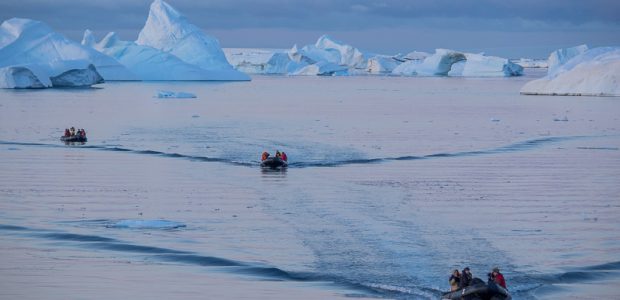Critique Submissions‚ January 2001
This page contains selected January 2001 submissions from photographers who wish to have their photographs reviewed by the publisher of this site,Michael Reichmann, as well as by other readers on ourDiscussion Forum. For additional details see theCritique / Contestpage.
Leigh Perry
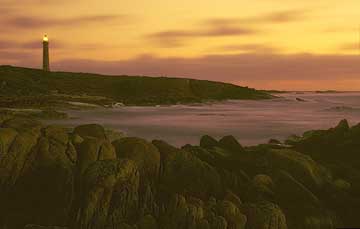
Leigh Perry
Sydney, Australia
lperry@breakpoint.com.au
Provia 100F, Canon 17-35L lens, Canon EOS 50. Exposed 30 seconds at f/16. Digital processing: levels adjustment.
This shot was taken at Cape Leeuwin, the most south-easterly point of Australia. The lingering West Australian twilights in November exhibit a warm lucency that was a new experience for me. During the period of this exposure, strong winds propelled clouds across the sky, and large waves rolled into the bay.
Michael’s Critique
Leigh understands colour. The warm complimentary tonalities in this image just sing. Compositionally this is also an excellent photograph. Everything that’s needed‚ no more, no less. Superb.
You can add your own comments on Leigh’s photograph on the Critique section of ourDiscussion Forum.
Ely E. Spivack

Ely E. Spivack
Canon AE-1 Program w/28 – 55mm lens film: Elitechrome (?)
This photograph was taken in Maui, Hawaii in August, 1999, o n the way back down from Haleakala crater after sunrise.Michael’s Critique
What am I missing here? Is the inclusion of the telephone poles an intentional part of the composition? Without them there’s potential interest because of the colour. But with them included I’m left wondering what Ely was trying to convey.
You can add your own comments on Ely’s photograph on the Critique section of ourDiscussion Forum.
Rich Shelton
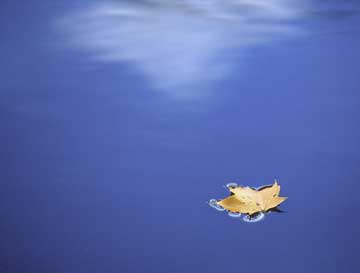
Rich Shelton
Westport, Connecticut USA
rich@sheltons.net
http://www.sheltons.net/rich.htm
I took this shot in a pool along a local trout stream. I tracked this lone leaf (with miniscus) against the reflected sky and broken clouds using an F100, Nikon 80-200 f/2.8, and Ektachrome E100VS (via LS-2000 scanner). find that the blue and golden hues are nearly exact inverses of one another!
Michael’s Critique
Rich has done an excellent job, producing a simply, beautifully composed study of contrasting forms and colours.
Colour contrast is one of the least understood areas of contemporary photography. While most painters who have some formal training study colour theory, it’s rare to find a non-academic photographer who understands colour on more than a "gut" level. For this reason I am developing a tutorial on colour theory for photographs. It should be online some time in January, 2001.
You can add your own comments on Rich’s photograph on the Critique section of ourDiscussion Forum.
Scott Hoerner
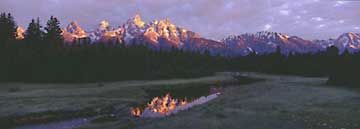
Scott Hoerner
www.skylightimaging.com
Scott@skylightimaging.com
Teton Alpenglow – Hasselblad X-Pan, 45mm at f/16
I took this on a recent trip to Grand Teton NP in June. This was taken a little further down the trail from Schwabecher’s Landing at sunrise. I have been extremely impressed with the results from my X-Pan. This image has been sold into several corporate collections as a 50 inch lightjet print. I would have liked to have had the new 30mm so I could have moved closer to the reflection to make it more prominent. Unfortunately composition options were limited by the need to keep the focal length of the lens and need to keep the reflection and mountains in the frame. I look forward to returning this year with a Fuji 680 with lens movements to allow me some better compositional choices.
Michael’s Critique
I hesitated to display this photograph because it suffers from being shown at much too small a size. I’m sure that in a large print it "sings", but when displayed as a 5" thumbnail its voice is too muted to do it justice. Also, the JPG submitted was much too dark and I’ve taken the liberty of lightening it somewhat, though I’m not sure of Scott’s original intention.
You can add your own comments on Scott’s photograph on the Critique section of ourDiscussion Forum.
Bill Green 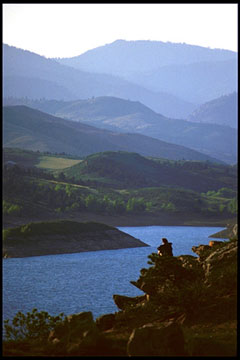
Bill Green
Englewood, Colorado/USA
billgreen@greenacrestech.com
Canon 100-400 at 400, handheld (I know, I know) Provia F +2
The image was shot at Horsetooth Res. in Fort Collins, Colorado. The lake is being drained so the dam can be repaired. I was taking my dog for a swim and later shooting a sunset that never materialized. While I was walking back to the parking lot I saw this person looking over the area from a rock ledge. Since I always wanted to take a picture like this, clichÈ as it may be, I grabbed my camera off the tripod, put on my longest lens and scrambled up some rocks to take this image.
Michael’s Critique
People in the landscape are tough to do well, and Bill has succeeded with this photograph. I particularly like the way he has framed it so that the point of land acts as an arrow to where the person is located. I also like the receding blue tones of the mountains and the rich greens. Nicely done.
You can add your own comments on Bill’s photograph on the Critique section of ourDiscussion Forum.
Paul Stenquist
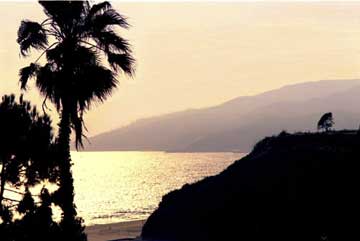
Paul Stenquist
Bloomfield Hills, Michigan, USA
pnstenquist@earthlink.net
Pentax Spotmatic F on tripod, Pentax Super Takumar 85/1.9 lens, polarizer, exposure was f11 at 1/500 second. Kodak Portra 160 VC color negative film. Scanned from the negative.
In autumn, the late afternoon sun creates some very intense light on Santa Monica Bay and the hills just north of the bay. I used a spotmeter to measure the light in the sky and exposed to get a zone six value. This silhouetted the shaded palm tree and the hills on the north edge of Santa Monica canyon. The camera position was on the south edge of the canyon. The sun is out of frame to the left but well above the horizon.
Michael’s Critique
The ingredients are all here‚ interesting light and strong composition elements. But, somehow it doesn’t work. There’s no flow; no unity to the disparate pieces. My eye has nowhere to rest‚ no focal point.
On a separate note‚ wow, a Pentax Spotmatic F‚ my first serious camera system back in 1965. Great camera.
You can add your own comments on Paul’s photograph on the Critique section of ourDiscussion Forum.
Eric Taylor
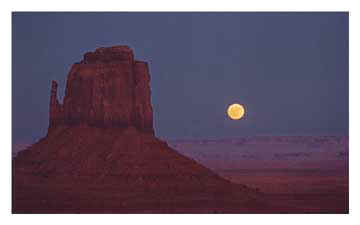
Eric Taylor
Toronto, Canada
polky@interlog.com
http://www.interlog.com/~polky
East Mitten Butte, Monument Valley, ~200m from visitor center, Nikon F601, Sigma 170-500mm, Manfrotto Tripod/Ballhead, Kodak Royal Gold 100
Monument Valley was one stop on my trip of the ‘grand circle’ which was planned around the full moon in Oct 2000. This shot was almost missed since the location I was shooting from had the moon positioned behind the butte…so much for the guides advice! Watching the moonrise in Monument Valley was a magical experience.
Michael’s Critique
Eric’s photograph is very successful. Perfect timing and a great location. Though a clichÈ, Monument Valley is one of those places that always challenges photographers.
You can add your own comments on Eric’s photograph on the Critique section of ourDiscussion Forum.
Dennis McKenzie
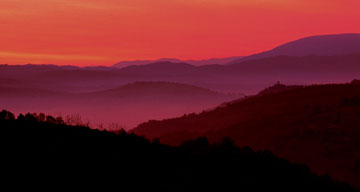
Dennis McKenzie
Wasilla, Alaska, USA
djmckenzie@webtv.net
Nikon N80, Nikon f 2.8- 80-200mm ED lens, might have used 2x converter, Provia f100 pushed to 200. Worked in Photoshop to look just like the slide.( for a change) Scanner HP Photosmart S20 My son and I spent 24 days in Italy this last Nov. and Dec. touring the country by motorhome having a great time in one big photoshoot. When taking a back road from Gubbio heading southwest we found a great place to pull off for the night with a great view of the country side. We did some shooting that evening but it was the next morning at dawn when this rich red sky slowly began to reveal itself and put on quite a show! Work done in Photoshop was to make the print look like the slide, and I do like to play in Photoshop but not this time.Michael’s Critique
Though the colours seem over-the-top, I can believe them‚ though I usually see such a strong palette only in the Western US. Sometimes nature paints with a very strong brush.
The photograph is a little weak overall because there isn’t enough interest in the landscape itself, and so it has to be carried by colour alone.
You can add your own comments on Dennis’ photograph on the Critique section of ourDiscussion Forum.
George Pence
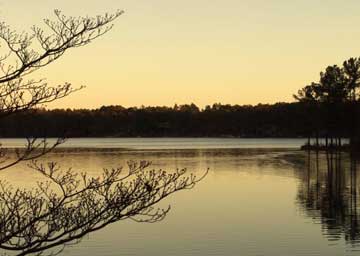
George Pence
Winnetka, Illinois – U.S.A.www.george.pence.comgeopence@hotmail.comI took this picture at Lake Thagard, a small body of water that is located in Whispering Pines North Carolina. The picture was taken on Christmas day at about 4:00 PM with an Olympus E-10 set to ASA 80. The lens aperture was set to F5.6 and the shutter speed was 1/100th of a second. I adjusted the picture in Paint Shop, cropping it slightly to eliminate some sky and increasing the red and green channels by 10% each.
Michael’s Critique
This is a gentle scene and the colours nicely evoke the time of day and season. I’m not completely happy though with the foreground branches, as compositionally they are too strong for the softness of the rest of the frame. Also, the upper branch forces there to be too much uninteresting sky in the rest of the frame.
You can add your own comments on George’s’ photograph on the Critique section of ourDiscussion Forum.
David R Stout
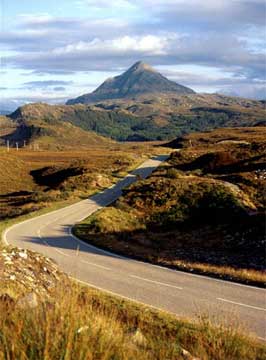
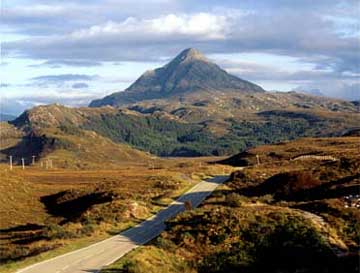
David R Stout
City/Country: Cambridge, England
david.stout@dial.pipex.com Canon EOS 50E with EF 20-35mm lens. Fuji Sensia 100 The Road to Ben Stack While returning from the north coast of Scotland, the sun broke though the rapidly clearing cloud. As I approached the nearest settlement, I glanced in the rear view mirror and saw this scene. I stopped the car and turned around, driving a mile or so until I found a convenient place to stop. I chose to use the bend in the road as a lead in to the distant mountain (Ben Stack). Michael’s Critique
The locale is lovely and the photograph well seen. But, the bottom third of the frame doesn’t add anything. Yes, it’s a classic S curve, and ones eye is drawn by it to the mountains and sky in the background‚ which are the real focal point. But interest-wise the bottom third of the frame leaves me cold.
The cropped frame to the right would be my proposed alternative. The beauty of the scene is retained while the mountain is made even more predominant, and the road still acts as a path for the eye into the frame.
You can add your own comments on David’s photograph on the Critique section of ourDiscussion Forum.
George Kmetz

George Kmetz
Huntington,CT
Stony Brook in Harriamn State Park,New York.
Contax S2, Zeiss28-85 @ 85mm, Velvia 50ASA, Heliopan Cir-Polarizer, Tripod, exposure not recorded as my footing slipped and got I my feet soaked, fortunately not my equipment.
Michael’s Critique
This photograph makes me feel cold. It captures the colour and texture of an overcast winter day with great charm. The exposure is clearly several seconds and makes the flowing water a bit too ethereal though.
You can add your own comments on George’s photograph on the Critique section of ourDiscussion Forum.
Colin Kimball
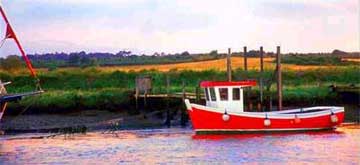
ColinKimball
This photo was taken in Southwald England as the sun was setting and the tide going out. We had been sitting in the car having tea during a light rain shower and as soon as it let up, the sun peak out for a brief moment. On our way to have some fish and chips, I spied this boat and grabed my camera to take this photo. It was shot handheld with a Nikon N90s using a 20-120 lens. Exposure data was unrecorded. Film used was Kodak Ektachrome 100VS. The slide was scanned on a photo cd. Some powerlines in the background were removed by photoshop as well as a distracting radar reflector on the top of the boat. Reds reflections in the water were enhanced with a saturation tool.
Michael’s Critique
This is such an "English" scene and description that it makes me smile. My only real objection is with the prow of the boat on the left intruding into the frame. It adds nothing other than a visual distraction.
You can add your own comments on George’s photograph on the Critique section of ourDiscussion Forum.
Paulo Bizarro
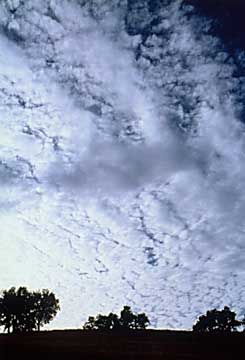
Paulo Bizarro
The shot was taken with a Nikon FM2n, 28 f/2.8 AIS Nikkor, E100VS, and tripod. Exposure was 1/500 at f/8. This is one typical scenery one can find in southern Portugal’s Alentejo province in the summer. I wanted to silhoute the olive trees against the vast expanse of sky.
Michael’s Critique
Almost always the best photographs are the results ofcontrasts. In this very well executed example Paulo has taken a minimalist approach, using the monochrome silhouette of the trees and hill-top to provide a contrast with the gentle blue colour and textures of the cloudscape. Lovely.
You can add your own comments on Paulo’s photograph on the Critique section of ourDiscussion Forum.
Chris VenHaus
![]()
Chris VenHaus
Waukesha WI USA
drmr@execpc.com
This shot was taken at the Horicon Marsh (WI) in the Spring of 2000, shortly after a storm moved through the area. I used my Canon A2E, Canon 35mm f2.0 lens, Bogen tripod, and Fuji Velvia. I actually had to desaturate the red channel in Photoshop because the red was so intense that it didn’t look real. A bit of unsharp mask was applied just to the foreground reeds and dark horizon line. Scanned with a Minolta Scan Speed.
Michael’s Critique
It’s been said that landscape photographers don’t photographplacesbut rather what these places look like in different weather. As a storm clears is almost always a wonderful time if you’re in the right location. This composition is a bit messy but it’s a strong image nevertheless.
You can add your own comments on Chris’ photograph on the Critique section of ourDiscussion Forum.
Cees de Vries
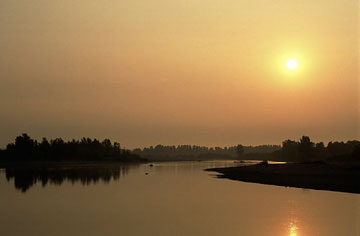
Cees de Vries Castricum The Netherlands Nikon F90/N90 Nikon 70-180 macro-zoom at around 80 mm Fuji Sensia Sunrise over one of the last unspoilt rivers in western Europe: the Allier in central France. Looking out of my tent at 5.30 one morning in early june I was struck by the superb colours, or rather the monochrome. No cropping, no colour-correction, just a little sharpening in Photoshop after scanning the slide with Nikon Coolscan III (LS-30).
Michael’s Critique
An elegant and delicate photograph. But my preference would have been to crop it to a more "panoramic" format. This would lose a bit of unneeded sky and also the reflection of the sun, which disturbs me because of being chopped in half in the current framing.
You can add your own comments on Cees’ photograph on the Critique section of ourDiscussion Forum.
Andrea Aughinbaugh
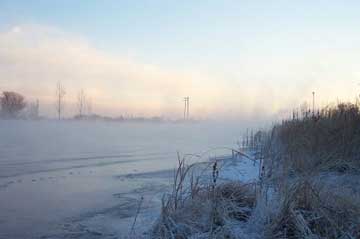
Andrea Aughinbaugh
Greeley, Colorado USA
andreaau@excite.com
Kodak DC280 digital camera, all automatic settings
Right now I have no extra filters or lenses, I have only what came with camera. Am a novice level photographer looking to learn how to improve my shots.
Michael’s Critique
What a missed opportunity. I won’t be too harsh because Andrea is a beginner, but the light and location certainly seem to have offered an opportunity to create a strong photograph. Other than the tilted horizon (tisk, tisk) the real issue is that the horizon line is cluttered and the hydro poles don’t exactly contribute great esthetic value. If the shoreline had been made more the center of interest with just a bit of the pink sky near the top of the frame it could well have been a much stronger image. Good try though.
You can add your own comments on Andrea’s photograph on the Critique section of ourDiscussion Forum.
Andrew Eksner
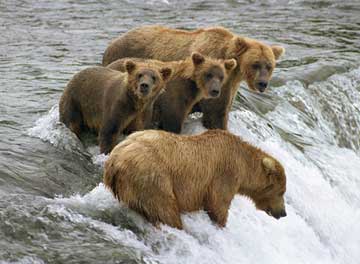
Andrew Eksner
Marina del Rey, CA
andrew@methodstudios.com
I took that picture with my Minolta Maxxum on Agfa Optima II in Katmai NP, Alaska in July’2k
Michael’s Critique
An appealing shot. The startled expression on the baby bear’s face is eye-catching. But, without those magic jumping salmon visible in the frame there’s no "decisive moment".
You can add your own comments on Andrew’s photograph on the Critique section of ourDiscussion Forum.
David Cassidy
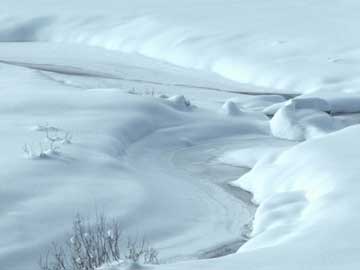
David Cassidy
Fountain Valley, California
dlcassidy14@yahoo.com
Canon AE-1, Kodachrome slide scanned
Near South Lake Tahoe, Trout Creek runs through one of the meadows protected from development by virtue of their status as part of a 100 year flood plain. These beautiful meadows are only slightly above the altitude of Lake Tahoe at approximately 6200 feet.
Michael’s Critique
Close, but not quite. There’s just too much going on and the colour is off. Graphic snow scenes like this need to have extremely clean whites (or be done as black & white), and be stark in their simplicity. This example has no center of interest.
You can add your own comments on David’s photograph on the Critique section of ourDiscussion Forum.
Andres Suurkusk

Andres Suurkusk
Estonia
www.suurkuusk.com
I took this shot with Kiev88, 80/2.8@8 lens, Velvia film, handheld.
Michael’s Critique
Simple, clean and appealing. I like the off-center tree and its balance with the tree’s shadow. While normally I prefer to see images cropped to eliminate clear sky areas, here retaining the square format works well because of the contrast between the deep blue and the clean white of the snow.
You can add your own comments on Andres’ photograph on the Critique section of ourDiscussion Forum.
Erik H. Pronske
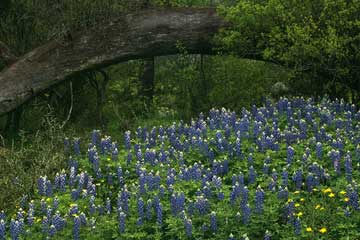
Erik H. Pronske, M.D.
Austin, TX
Minolta 9xi, 25-85 lens , Velvia
Texas Hill Country in the spring. These are Texas Bluebonnets (known as lupines in other parts of the country) that bloom in the spring and provide beautiful color to the countryside. A fallen live oak tree serves as a frame to the image.
Michael’s Critique
One of these years I’m going tohave toschedule a shoot in Texas Hill Country. I’ve seen so many captivating images from this area that it seems a must. Eric’s photograph does a wonderful job of capturing the feel of the woods in Spring. A large original print must be quite lovely.
You can add your own comments on Erik’s photograph on the Critique section of ourDiscussion Forum.
Jeff Alu
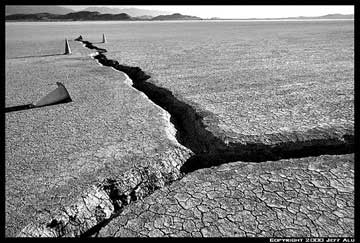
Jeff Alu Irvine, CAanimalu@animalu.com This was taken at El Mirage Dry Lake, Southern CA, using a Kodak DC-280 Digital Camera. There were large cracks in the mud, and cones were put up to prevent Cyclists/ATCers from riding into them. I thought it made for a very surreal combination of natural and man made elements. The cracks were much more extensive than what is shown here. I say "were" because they no longer exist, and have been filled in with dirt as can be seen athttp://www.animalu.com/pics/sad.jpg.
Michael’s Critique
This is a striking image‚ made Dali-esque by the traffic cones. The tilt of the north-south crack creates a crazy perspective that is belied by the level horizon, and the turned-over foreground cone adds the perfect surreal touch. Great photograph Jeff. Well seen and executed.
You can add your own comments on Jeff”s photograph on the Critique section of ourDiscussion Forum.
Don Weston
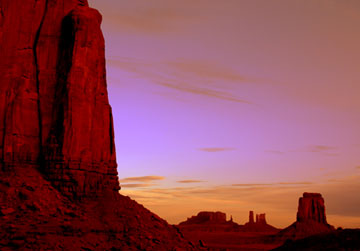
Don Weston
Farmington, CT. USA
Bladnut@aol.com
This photo was taken with a Canon D30 digital camera with a EOS 28-135mm IS lens around sunrise Xmas eve morning 2000. It was downloaded to a PC converted by Canon software and resized in Photoshop LE 5.0. The only manipulation done was contrast, brightness and saturation to a minor extent.
Michael’s Critique
I’m a sucker for photographs from Monument Valley, and since in this case it was taken with the new Canon D30, which I’m particularly fond of, the more so. Don’s image is very well seen. This is a framing which I haven’t seen before. The balance between sky and butte is handled very well. A lovely and appealing image.
I’m particularly taken with the luminosity of the colours in the sky. This colour rendition is a signature of the D30 and shown here to full effect.
You can add your own comments on Don’s photograph on the Critique section of ourDiscussion Forum.
Jason Larson
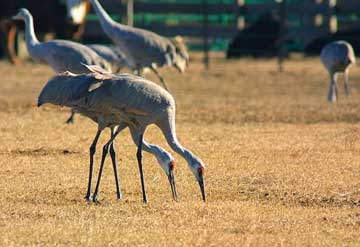
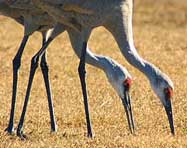
Jason Larson Gainesville, Floridajlarson@shadowplayphoto.com Canon D30 – ISO 200 – Daylight White Balance Tamron 200-400 zoomed to 400mm F8 @ 1/500 Cropped, Levels and Unsharp Mask in Photoshop This shot was taken with my new D30 on a very cold (for Florida anyway), 27Æ’ Sunday morning. Gainesville is on some migration route for Sandhill Cranes. Once a year they descend upon this field, there were hundreds of them there.
Michael’s Critique
There’s potential here, but it’s a miss. The two cranes are symmetrical and therefore appealing but the rest of the frame is messy. The cropped section that I’ve created above is for me what this image is all about. Unfortunately it looks like a much longer lens would have been needed to create a high quality frame that tight.
This type of wildlife photography is very tough. It either requires isolating the animal almost completely, so that what you essentially have is a portrait, or you need to show the creature in its habitat, but with a clean composition.
You can add your own comments on Jason’s photograph on the Critique section of ourDiscussion Forum.
G¸nter Haika
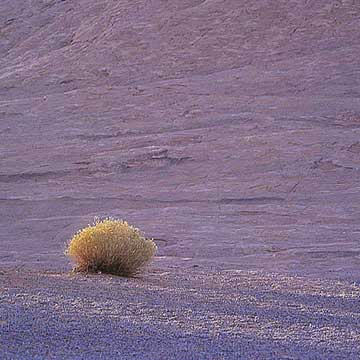
G¸nter Haika
Vienna, Austria
haikagk@wfu.edu
http://haika.de.vu/
Hasselblad 503CX, Sonnar 5.6/250 SA with Mutar 2x,2s@f-45. Fujichrome Provia.
Valley of Fire S.P., NV; Dec 16, 2000, just after sunrise.
Michael’s Critique
While it’s a well composed and executed image I can’t muster very much enthusiasm for this photograph. There’s just too much uninteresting rock face. The bush and foreground have contrast and colour but the background makes the composition banal. Cropping can’t save it now‚ it likely would have been more interesting from a different angle where the bush and the foreground shadows were more prominent.
You can add your own comments on G¸nter’s photograph on the Critique section of ourDiscussion Forum.
Rick Sovitzky
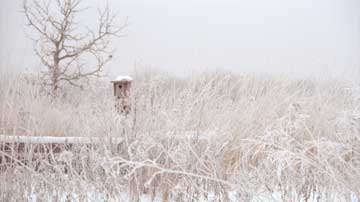
Rick Sovitzky Greenfield, WI USArsovitzky1@wi.rr.com Shot with Minolta Maxxum 7000, Minolta 35-70, exposure not noted, on Kodak Supra 100. Scanned by HP S20 with Vuescan. Cropped with Paint Shop Pro v7. Driving through Wehr Nature Center after fresh moist snow with fog/haze. I guess I’m a lot like Woody Allen – I like ‘soft’ days, cloudy, soft contrast. Kind of ethereal. Saw this birdhouse and scraggly tree contrasting with the softness and curves and wanted it. Is it TOO soft for most peoples’ liking?
Michael’s Critique
While theatmosphericsare appealing I can’t say the same for the composition. The bird house is too small and the log or rail in the foreground is too indistinct to be a useful part of the composition. The lone bare tree provides an interesting point of contrast but I don’t like the way in which it’s clipped off at the top.
You can add your own comments on Ricks photograph on the Critique section of ourDiscussion Forum.
°ke Vinberg
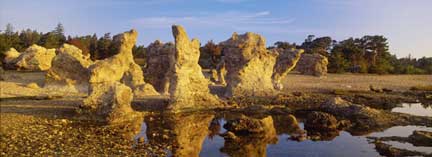
°ke Vinberg, Stockholm, Sweden
ake.vinberg@home.se
Location: Folhammar, east coast of the isle of Gotland, Sweden.
Date: July 2000, dawn. Equipment: Hasselblad XPan, 45mm lens, center ND grad filter, Cokin blue-yellow polarizer, tripod. Exposure unrecorded at f/11 on E100VS. Scanned in two frames on LS-2000 and stitched in Photoshop.
These calcium formations (called "rauk" in Swedish) are somewhat
Michael’s Critique
This is a fascinating photograph. I’ve never seen a shot of these formations before.‚¬°ke has done a very nice job of capturing the mystery of this location and the use of the B/Y polarizer has nicely enhanced this.
You can add your own commentson‚¬°ke’s photograph on the Critique section of ourDiscussion Forum.
Anders Wahlstr ‚œm
Anders Wahlstr ‚œm
Stockholm
Sweden
anders.wahlstrom@telia.com
Canon Eos 30 , EF 70-210/4 , Fuji Provia 100F , Mannfrotto 055 Tripod , Scanned with Minolta Dimage Scan Dual II, Some level adjustment in PS 6.0
The island of Sing ‚œ in the northern Stockholm archipelago on New Years Day 2001.
Michael’s Critique
Ander’s photograph is very strong. The dark sky contrasting with the snow-covered woods is very dramatic. My only suggestion would be to crop the frame just slightly at the bottom‚ just where the reflection begins.
You can add your own comments on Anders’ photograph on the Critique section of ourDiscussion Forum.
Thomas W. Earle
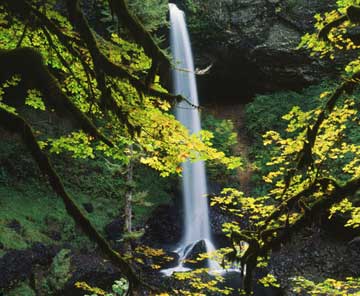
Thomas W. Earle Pendleton, Oregon (USA) twade@bmi.net
Fuji Provia 100F @ ASA 100 , 1/2 sec @ f/22 , Pentax 67, 105 mm
This photograph was taken in Silver Falls State Park, just east of Salem, Oregon. The photo is a picture of North Falls during the fall of 2000
Michael’s Critique
This is an "almost". It has all the fix’ns but somehow just misses. The waterfall is too ethereal. Thomas indicates a half second exposure but it looks longer to me. My experience is that about an eighth of a second works best. Also the dark tree limbs and yellow/green foliage are lovely but I don’t like the way the branch interrupts the waterfall. It should frame it, not bisect it.
You can add your own comments on Thomas’ photograph on the Critique section of ourDiscussion Forum.
Don Dixon
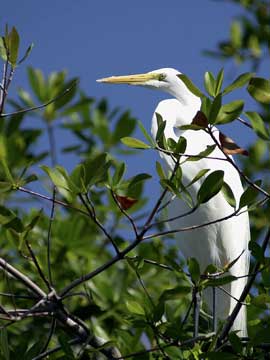
Don Dixon
204 Tinkers Ct.
Wausau, WI 54401
White Heron in Mangroves taken in the Florida Keys 2 weeks ago.
Nikon D1 & Nikkor 80-200 F/2.8 AF w circular polarizer. Exposure: 1/500 sec – F/4.5 Lens: 80-200mm F/2.8
Michael’s Critique
This is a strong wildlife image. But, like with the waterfall photograph immediately above it is compromised by the foreground foliage. I realize that it is often difficult if not impossible to frame a good shot in any other way, but we all need to keep in mind that the best images use foreground objects like branches as frames rather than obstructions.
You can add your own comments on Don’s photograph on the Critique section of ourDiscussion Forum.
Miles Hecker
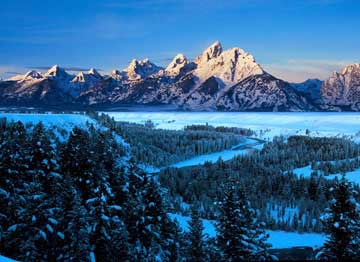
Miles Hecker
Casper,WY
mhecker@acad.cc.whecn.edu
Contax Aria 35mm lens Provia 100f 1/15sec f9.5
Ansel Adams made this spot famous in his National Parks series of photos. Most Teton vistas look best in the summer or fall, but this is one I think takes on a special character and ethereal nature at sunrise in winter. On this morning, Xmas day 2000, it was -10 degrees F. I was using my Contax to meter for my Fuji 690 which was on another tripod alongside it. The 120 film was dropped in the local developer tank and lost by the local pro shop. All that remains of this moment is a 35mm slide.
Michael’s Critique
Not knowing what the lost Fuji 690 shot looked like I can only judge the one above. I like it a great deal but would make the following changes. The main one is colour balance. The foreground area in shadow is mostly cyan rather than blue. This could be as a results of the processing or the scan. Regardless, it’s a bit disturbing. I would also crop the very bottom of the frame to remove the white (cyan) corner, as it’s distracting from the overall fine composition.
You can add your own comments on Miles’ photograph on the Critique section of ourDiscussion Forum.
Steve Cerocke
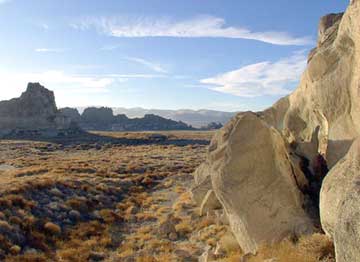
Steve Cerocke
Sparks, Nevada
steve@iqcorp.com
Shot taken with the Olympus E-10 digital camera at Pyramid Lake Nevada. Shot in JPEG mode with minimal post processing in Photoshop. These rock formations are called Tufa Rock. They come in many interesting forms and shapes created by mineral reactions beneath an ancient inland sea. The shot was taken in the winter after the tumbleweeds in the foreground had turned a rich browish orange.
Michael’s Critique
Overall this is nicely done, but compositionally it lacks a strong center of interest. The sky is also too hot at left-center frame. A split ND filter would have helped a great deal.
You can add your own comments on Steve’s photograph on the Critique section of ourDiscussion Forum.
Michael A. Jazayeri
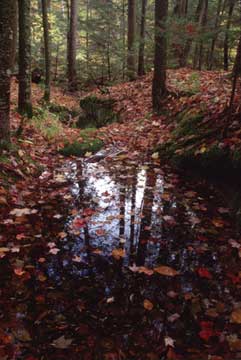
Michael A. Jazayeri, M.D. 1303 Reggio Aisle Irvine, CA 92606
This photo was taken in New Hampshire in fall. I used a Canon Elan IIE with a Canon 20-35 USM lens at F 16. I used a Tiffen warm polarizer to cut the reflections in the pond and do give warmth to this overcast seen. A Bogen 3021 tripod was used to steady the camera
Michael’s Critique
A charming scene. An archetypal walk in the woods. I can smell the Fall air.
The composition could be improved if a lower viewpoint had been selected. It’s just a bit too "eye-level" and being lower and closer might have made it a bit more intimate.
You can add your own comments on Michael’s photograph on the Critique section of ourDiscussion Forum.
Alan Cameron

Alan Cameron Torrance Scotlandcameron.locheil@btinternet.com Technical details: Nikon cp950, , f7.4 1/182 s 3 digital images left to right stitched together to give panoramic view. Originals shot at 1600×1200 fine mode, final cropped stitched image is 3994 x 1447 @72 dpi Rannoch Moor Scotland, my favourite place for getting away from the city (Glasgow). Unusual to have a cloudless sky in this part of the world…… not that I was complaining. Due to the heavy frost on the ground it made it easier to access the pools, ponds & streams around this area without getting bogged down.
Michael’s Critique
I’ve been seeing some outstanding digital panoramas recently, and this is one that I particularly admire. Doing these stitches overcomes the current resolution limitations of consumer digital cameras.
Alan’s composition is first-rate. What a great locale. Well seen.
You can add your own comments on Alan’s photograph on the Critique section of ourDiscussion Forum.
Josh Levy

Josh Levy
Chapel Hill, NC, USA
jlevy3@nc.rr.com
Canon Eos-650, Canon EF-22-55 mm wide angle zoom, Fuji Reala 100 , 3 shots, stitched using PowerStitch
This shot of Mawenzi peak was taken just before dawn from about 18,000 feet on Kibo peak, Kilimanjaro, Tanzania, Aug. 2000. I’ve never seen anything like it…The horizon really was curved.
Michael’s Critique
This photograph is less effective as art than it is as record. The sweep of the panorama is appealing but doesn’t capture me. I’d much rather see a closer view of the mountain peak climbing out of the clouds with the orange sky behind.
You can add your own comments on Josh’s photograph on the Critique section of ourDiscussion Forum.
Attila Kirjak
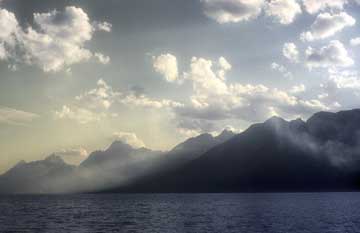
Attila Kirjak
http://www.mailzone.com/~kiru
New York
The picture was taken in Summer 2000 next to Jackson Lake, the smoke in the valleys are from some of the forest fires in the region.
Canon EF 50mm f1.8 lens, 1/50 sec at f11, no filter, tripod, on Provia 100F.
Michael’s Critique
There is sometimes only a fine line between art and record. Here, because of the smoke and the way the light intersects it, we have a beautifully seen image. Lovely juxtapositions of light, form and contrast.
You can add your own comments on Attila’s photograph on the Critique section of ourDiscussion Forum.
Cary Bradley
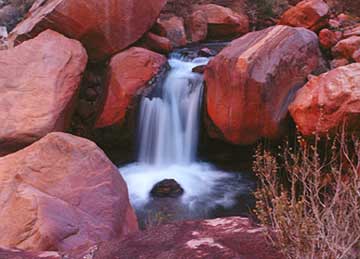
Cary Bradley
Marietta, GA
This photo was shot on December 31, 2000, while I was backpacking in the Grand Canyon. It is a small waterfall on Bright Angel Creek, near Phantom Ranch. It was taken with a Canon EOS Rebel G, Fuji Reala file (ISO 100), shutter speed 2 seconds, aperture unknown. My tripod was not handy, so I used a rock. Scanned from a print, using a low-end HP flatbed scanner.
Michael’s Critique
While I like the image I have two problems with it. The first is the bush on the right. The composition would have been much cleaner without it. Second an otherwise strong photograph is let down by poor reproduction. The color balance is way off‚ likely as a result of it being a poor scan from a print. Too bad.
You can add your own comments on Cary’s photograph on the Critique section of ourDiscussion Forum.
Lucas Condliffe
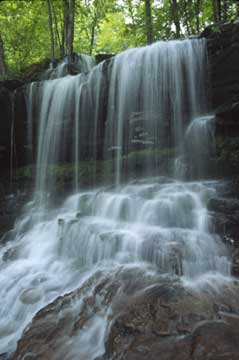
Lucas Condliffe
Vernon N.J
I took this picture in a town called Roxbury N.Y. with a Canon A2E with a 28-70L lens, tripod, provia100F didn’t record the exposure and I scan it in with a umax powerlook3
Michael’s Critique
A classic waterfall shot. Very well done. I like the fact that it isn’t tiled backward the way so many are because they’re done without perspective controls lenses or cameras. By have the falls positioned at eye level these distortions have been avoided. Shutter speed is perfect for imparting a feeling of motion to the water without turning it into a cloud. The green trees above add a lift and a colour contrast needed to make the image work as a whole.
You can add your own comments on Lucas’ photograph on the Critique section of ourDiscussion Forum.
Jeffrey Goggin
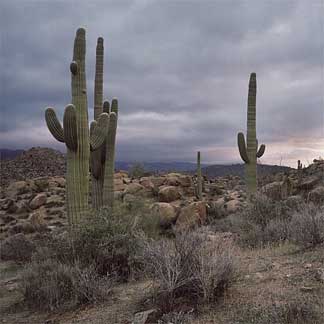
Jeff Goggin
Scottsdale, AZ
This photo was shot about 20 miles north of Scottsdale, Arizona, just past the Four Peaks turnoff on SR87. It was taken mid-morning on a dreary day with a Minolta Autocord III (purchased on eBay for a mere $79.50) and Provia. I didn’t record the exposure settings although I’m fairly certain it was shot at f/11 as the foreground turned out a little softer than I expected. The image isn’t cropped and had only the levels adjusted and some sharpening added using Photoshop 5.5.
Michael’s Critique
There’s a sense of mystery about this photograph. The light is appealing and has the mood of something impending. The composition is somewhat static but in some ways that adds to the charm. A bit less foreground might help.
You can add your own comments on Jeff’s’ photograph on the Critique section of ourDiscussion Forum.
Ed Buchwald
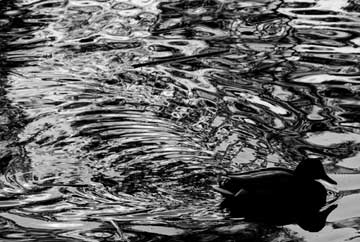
Ed Buchwald
Cambridge, MA
buchwald@mit.edu
EOS D30, Canon 28-135mm IS lens, ISO 400, 1/100 sec. @ f6.7 , 132mm focal length
Michael’s Critique
The image was taken at Descanso Gardens in La Canada, CA, which is a preserved estate in the San Gabriel mountains with magnificent flowers and a duck pond. Though it was quite dark by 4PM, I was able to get several shots before having to use a flash. The patterns on the water at this late time of day, with the sun low on the horizon, were particularly striking.
Another duck picture 🙂
But, a fascinating one. The chaotic state of the ripples and the placement of the duck in the lower right of frame‚ so that it’s swimming out of our field of vision, creates a terrific dynamic tension. Not your everyday duck shot.
You can add your own comments on Ed’s photograph on the Critique section of ourDiscussion Forum.
Nancy Patrick
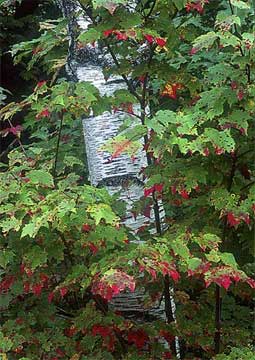
Nancy Patrick
Casper Wyonancypa@trib.com
Contax Aria, 35-70mm Velvia, 4 sec at f19
This picture was taken in Monadock State Park in New Hampshire this fall. The day was highly overcast which created a gentle diffuse lighting.
Michael’s Critique
Birch trees and autumn leaves are a striking combination. This composition though feels somewhat cluttered. Consequently, while it’s enjoyable to look at there’s no real center of interest and after a few moments there isn’t much to hold my interest.
It should be said that this is one of those images that is best done in medium or large format, where the ability to see the tiniest detail helps create an interest of its own. 35mm lets down this type of subject matter.
You can add your own comments on Nancy’s photograph on the Critique section of ourDiscussion Forum.
Kevin Ferris
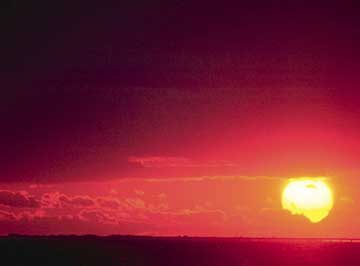
Kevin Ferris
New York City
KFerris575@aol.com
This sunset photo was taken on Long Island, New York last January. I was out photographing whitetail deer using a 500mm F4.5 lens and Kodachrome 200 film in the camera. The sunset was not very interesting except for the area right around the sun. I took a few frames but I didn’t expect much because Kodachrome is not as saturated as the newer E6 films. I was suprised at how saturated the red in the slides came out since the actual scene was not nearly as colorfull as the slides.
Michael’s Critique
Strong sunsets like this are fun, but this one is a bit over-the-top in terms of colour saturation. Placing the sun off-center as Kevin has, at first seems like a good idea but it leaves me feeling as if the sun is about to roll off the right side of the page.
You can add your own comments on Kevin’s photograph on the Critique section of ourDiscussion Forum.
Doug Selfe
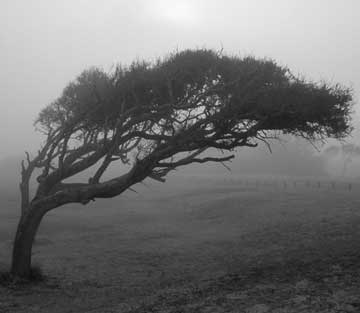
Doug Selfe Wilmington, NCdss@ec.rr.com Canon EOS-3, Canon 28-135 IS lens, Provia 100F, exposure not recorded. Scanned with Sprintscan 4000. Levels adjusted and picture converted to greyscale in Photoshop. This picture was taken at Fort Fisher historic site in North Carolina. As an historical note, Fort Fisher was the last fort to fall during the Civil War. The site is not more than a 100 yards from the ocean and is dotted with wind blown live oak trees like this one. It was very foggy this day, with visibility down to just a couple hundred yards. The original colors were muted greys, browns, and yellows (typical for winter in this area) so the conversion to greyscale seemed natural to me.
Michael’s Critique
I really like this image. It’s moody, beautifully composed and well executed. There isn’t much more to say. Study it to see how this type of photograph should be done.
You can add your own comments on Doug’s photograph on the Critique section of ourDiscussion Forum.
Edward Worcester
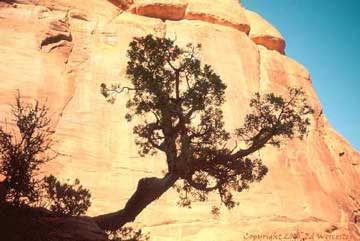
Edward Worcester
Toledo, Oregon
ewworces@gapac.com
Nikon FE2, old Vivitar 28mm f2.8, polarizer, sturdy tripod, Fujichrome ASA 50 rated at 50.
Slide was scanned at a local photo shop. It is unmanipulated digitally, except for adding my name in the lower right-hand corner (photo was used in business presentation). This photo was created at Arches National Park in Utah. I enjoyed the arches, but there is so much more beauty there that goes beyond the arches. This small tree was located adjacent to a popular trail. Being new to photography, I enjoy this photo because it is one of the first photos that I previsualized how I wanted the image to appear on film, then manipulated the camera in order to create what I saw (as opposed to simply "taking" a picture).
Michael’s Critique
This is a good try but doesn’t quite make it. Firstly the shot is slightly overexposed. The cliff is just too hot. Secondly I would have changed position and eliminated the sky‚ just isolating the silhouetted tree against the cliff face. Finally, I would have concentrated just on the main body of the tree, not the messy area to the left of the frame.
You can add your own comments on Edward’s photograph on the Critique section of ourDiscussion Forum.
You May Also Enjoy...
Join Michael in Antarctica
I have lead photographic workshops / expeditions to Antarctica five times previously. Just a few months from now, in January and February 2015, together with
Impact
Contact© Miles HeckerCLICK ABOVE IMAGE TO SEE GOOGLE MAP LOCATION SEASONS These bighorn sheep rams engage in full blown combat when the urge arises. The
